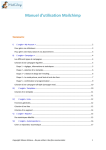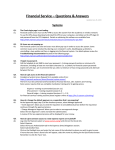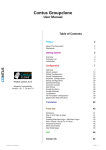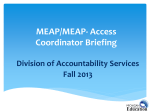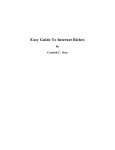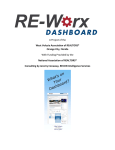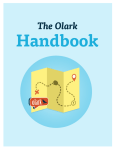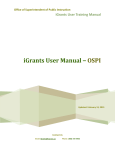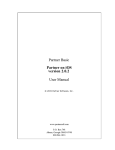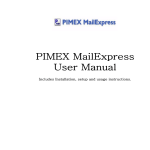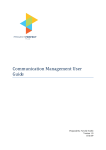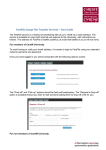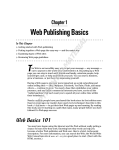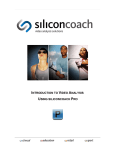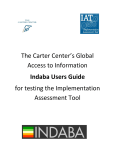Download Getting Started With MailChimp
Transcript
Welcome to MailChimp Email doesn't need to be overwhelming. This guide will help you get your first campaign off the ground. We’ll also offer tips for managing your list, viewing your reports, and making sure your newsletters get into the right inboxes. In this guide, you'll learn how to: Make sure your list is compliant Create and import your list Make and send your first campaign Avoid spam filters Understand your reports If you have any questions that are not addressed in this guide, MailChimp offers a variety of valuable resources for getting started, including our video index, a glossary of terms, a searchable Knowledge Base of how-to and troubleshooting articles, a selection of guides on our Resources page, and a helpful support team. Now, let’s get started. The Basics MailChimp is a web-based application that works in most web browsers, which means you don’t need to download or install any new software on your computer. To make sure that MailChimp works properly in your browser, you should enable cookies, pop-ups, and JavaScript. Before you watch our tutorial videos, you’ll need the latest version of Flash. Compliance tips When you create a MailChimp account, you agree to comply with all antispam regulations and MailChimp’s Terms Of Use. These terms require that all lists be permission-based, consisting of subscribers who signed up through a mailing list signup form or gave explicit permission for you to add them to the list. You must have tangible, confirmable proof that the subscriber wants you to communicate with them. Be mindful of these guidelines as you’re getting started: Make sure the intent of the signup form is clearly stated. All potential subscribers should understand that, by submitting their contact information through the form, they are agreeing to receive bulk email from you. “Contact Us,” “Apply For A Quote,” or “More Information” forms are not considered an acceptable opt-in method for bulk emails. These forms generally indicate a one-to-one email, not permission to be added to a bulk mailing list. Email addresses collected verbally, from personal address books, from business cards, or from social media/LinkedIn followers are not considered viable opt-in methods, due to their lack of tangible, verifiable proof of consent. While it’s generally okay to add existing customers to a bulk mailing list, they must be recent customers (having purchased a product in the past 6 months) or customers that have already been regularly receiving emails from you. Only use addresses that have requested to be added to a list. We do not allow any kind of third party lists in our system. This includes publicly available, purchased, rented, or partner lists. This KB article can help you determine if your list is acceptable. If you’re still unsure, contact our compliance team for further clarification. Creating and Importing a List The foundation of great email marketing is a clean, updated, engaged list of subscribers. Once you’ve created, confirmed, and logged in to your MailChimp account, you’re ready to start building that list. You can create as many lists as you’d like within your account, but for most users, we recommend maintaining a single list along with segmenting data and interest groups, as needed. This helps keep your list clean and your billing rate low, since our monthly rates are determined by your total subscriber count. Duplicate subscribers across multiple lists count toward that total. Creating your list To create a list in your MailChimp account, follow these steps: 1. Choose Lists from your MailChimp dashboard, then click the Create List button in the upper righthand corner. 2. On the List details page, you can choose a name for the list, set the default From name and email address, and write a short “permission reminder” to remind your subscribers how and why they’re receiving email from you. 3. When you’re finished, click Save. If you don’t have any subscribers yet, don’t worry! MailChimp will automatically generate a signup form for your list, which you can easily customize, share, post on your website, or even add to your Facebook page. We give you lots of options when you’re building the form, so you can gather exactly the information you need from your contacts. You can also use this information to segment your list later on. At MailChimp, we’re serious about security and sending reputations—yours and ours. By default, our signup forms require double opt-in, which helps maintain the integrity of your mailing list and can improve email deliverability and performance. For more information about the double opt-in process, refer to this article. Importing your list If you have an existing list of contacts or subscribers who have opted-in to receiving email from you, there are several different options for importing them into MailChimp. They include: Uploading a CSV or tab delimited text file. Copying and pasting your list from Excel. Importing contacts from your Mac Address Book with the help of our OSX app, MailChimp Import. Importing directly from a third-party application or program—like Salesforce, Google Docs, or Highrise—that integrates with MailChimp. For more details about our available integrations, visit our Integrations Directory. If your contacts are stored in an application or program that doesn’t currently integrate with MailChimp, refer to that program’s support documentation or customer support team for assistance with getting a CSV file of the contacts. Importing contacts using MailChimp’s API. (A quick warning here: the API is for experienced programmers and developers. If you don’t currently have someone on staff that can assist with this, consider reaching out to one of our for-hire, third-party MailChimp Experts to lend a hand.) Do you only need to add a single email address to your list? You can do so by clicking the add subscriber icon on the Lists page. Building and customizing signup forms When you create a list in MailChimp, we’ll automatically generate a series of signup forms and response emails. You can use the tools on the Create forms page to customize the Unsubscribe sequence, the Update profile sequence, and other list forms and emails that make up our double opt-in process. MailChimp forms are mobile-responsive, so potential subscribers can easily view and submit their information from a smartphone or other mobile device. Below, we'll cover the basic steps for creating and designing general forms in MailChimp, but there are a few other options on the Signup forms page for each list as well. Embedded forms - Generate HTML code for a form that can be embedded on your website or blog. Learn about the embedded form options here. Subscriber popup form The subscriber popup is a customizable form option that automatically displays a MailChimp signup form in a popup modal on your website shortly after someone visits the page. Form integrations - Build sophisticated forms and connect MailChimp to your blog and social media profiles. Integrations with Wufoo, CoffeeCup, Twitter, WordPress, and Squarespace are available here, too. Facebook form - Add a signup form to your Facebook page. Tablet form - Collect signups in your brick-and-mortar store or at events with Chimpadeedoo for iPad or Android tablets. Build it To build your signup form and begin customizing: 1. 2. 3. 4. 5. Navigate to the Lists page. Select the appropriate list. From within that list page, click Signup forms, then General forms. Click the Build it tab. All forms start out with three default fields: Email address, First name, and Last name. If you’ve imported a list containing additional fields, they'll be present on the form as well. To add extra fields, choose a field type from the Add a field tab on the right side of the page. 6. Once you've added any extra fields you need, you can customize field text and set default merge field values. 7. Click Save & Exit to save all changes to your form. Note: If you would like to add an extra layer of security to your form, check the Protect your signup form with reCAPTCHA box on the Create forms page. When this option is enabled, a Google reCAPTCHA checkbox that says "I'm not a robot." will be included on your signup form, preventing spam bots from adding email addresses to your list. Design it To the right of the Build it is the Design it tab. Here, you can choose the colors, styles, and fonts for the form or response email you've selected. It's important to note that style changes are made universally and not form by form. When you edit or make a change to any element of the form, we apply the same change to each of the other forms and response emails for your list. Visit our Knowledge Base for more tips on customizing the look and feel of your list forms and response emails. Translate it Use the Translate it tab to enable or customize translations for your list's forms and response emails in any of MailChimp's 40+ supported languages. Note: The subscriber popup form does not support translation. Creating Templates and Campaigns Once your list and forms are set up, you’re ready to start building an email message to send out to your subscribers. There are lots of names for this email—newsletter, blast, or e-shot just to name a few—but at MailChimp, we call each email message that you design and send to your subscribers a “campaign”. Each campaign is built using a preset layout called a “template.” In this section, we’ll cover the basics of importing or coding a custom template into MailChimp. If you’d prefer to use MailChimp’s built-in selection of templates to create a campaign, feel free to skip ahead to the Creating a Campaign section. Creating or importing a custom template MailChimp provides a variety of customizable Basic Templates and predesigned Template Themes that can be used as starting points for email campaigns, but you’re not limited to those options. If you’d like to import your own templates or create custom coded templates to help fill a specific design or branding need, just visit the Templates section of your account and click the Create Template button. Here, you’re able to paste in your own custom coded design or upload templates from an HTML or ZIP file. If you’d like to use one of our existing templates as a base for your custom design, you can do that here as well. Any templates that you create here will be found under the Saved Templates tab when you reach the Template step of the Campaign Builder. Note: To allow use of our visual content editing tools, you will need to code your templates using the MailChimp Template Language. Creating a campaign The MailChimp campaign builder walks you through building a campaign, step by step. When it's time to design your campaign, if you're not using an uploaded template, you'll find a variety of basic email layouts you can customize easily without HTML knowledge. Many of our layouts use a drag and drop editor, which makes it easy to add, move, delete, and style content blocks. If you want to use the same layout again later, you can save your design as a template for future campaigns. To get started, click the Create Campaign button from the Dashboard or Campaigns tab, and choose the type of campaign you’d like to create. Regular Ol’ Campaigns are the most common type of HTML email our users send. You can design and customize the designed HTML and plaintext versions of these emails, and choose whether to send them immediately or schedule them for later. Plain-Text Campaigns are the simplest form of mass email you can send. As the name suggests, these campaigns will only contain text, and have no formatting options. A/B Split Campaigns are a great tool for testing subject lines, From names, sending times, or—when combined with the *|GROUP:X|* merge tag—even content. We'll send two different versions of the email to small portions of your list, track their performance, then send the "winning" version to all remaining subscribers. RSS-Driven Campaigns allow you to automate your email marketing by combining content from an RSS feed with user-friendly MailChimp templates. Like the other campaign types, you can control when these campaigns go out and who receives them. If you'd like to create a series of automated emails, check out our robust Automation features. Our Working With Automation guide will help you get started. For now, we'll work with the Regular Ol' Campaign. The steps in the campaign builder will vary slightly across other campaign types, but the general behavior of templates will remain the same. After you choose your campaign type, you’ll begin the campaign building process. In a Regular Ol’ Campaign, the first step is Recipients. Here, you’ll determine which subscribers will receive the campaign. You can choose to send it to the entire list, or use our segmentation tools to send targeted content based on subscriber data, campaign or e-commerce activity, group membership, manual selection, and more. This article contains a quick tutorial on building segments and provides a full list of the available segmenting options. In the Setup step, you’ll decide on a name for the campaign (this will not be visible in the sent campaign) and enter general information like the email subject, From name, and From email address. You’ll also have the option to set up our Conversations feature to help manage replies and to personalize the “To:” field of your campaign through the use of merge tags. Note: If the associated list contains the names of your subscribers, checking the “Personalize the To: field” feature will allow you to use merge tags to help personalize each email. For example, *|FNAME|* *|LNAME|* would display as “To: John Smith” instead of “To: [email protected].” Not only are personal emails more likely to be opened, they're also less prone to get flagged by spam filters. Also included on the Setup step are a number of native and third-party tracking options, the ability to enable automatic sharing of your campaign on Facebook and Twitter, and authentication. Next up is the Template step. MailChimp offers a variety of basic templates and themes in each account. Basic templates provide you with a highly-customizable blank layout, so you can easily add your own styles and content using the drag and drop functionality of our Email Designer. The following basic layouts are available: 1 Column 1 Column - Banded 1:2 Column 1:2 Column - Banded 1:3 Column 1:3 Column - Banded 2 Column 2 Column - Banded 2:1 Column 2:1 Column - Banded Left Sidebar Layout Right Sidebar Layout Simple Text Basic RSS (RSS-Driven Campaigns only) Right Sidebar RSS (RSS-Driven Campaigns only) The only difference between non-banded and banded templates is their appearance. Non-banded templates are one solid color and have a defined border. Banded templates will have a “band” of color that stretches across the page and contains the footer information. Themes, on the other hand, are predesigned, preconfigured templates that don’t require any programming or design knowledge to use. Simply pick a theme, plug in your content, and you’ll have a beautiful campaign. Themes come in two varieties: “drag and drop” and “classic.” Drag and drop themes offer functionality similar to that of basic templates, while only the color and content of the classic templates will be editable within MailChimp's email designer. The template type will be displayed below each theme, so you can easily differentiate between the two. You also have the option to use Saved Templates, reuse layouts from drafted and recently sent Campaigns, or upload a template/paste in your own custom code from the Code Your Own tab. Add your content Once you've selected a template, proceed to the Design step. Here, you’ll use MailChimp's email designer to add, rearrange, duplicate, and delete content blocks to create a unique campaign that is fully customized to your needs. You can modify and style the content for specific content blocks using the Content, Style, and Settings tabs in the editor. Choose from the following content blocks: Text Boxed Text Image Group Image Card Image + Caption Image Divider Social Follow Social Share Button Footer Code RSS Header (RSS-Driven Campaigns only) RSS Items (RSS-Driven Campaigns only) In each content block, you can add and format text, upload images, link to files, and further tailor the layout for maximum flexibility and personalization using the editor toolbar. After you've added content, the blocks can be dragged vertically or horizontally within the template to mix up the layout and design. Click the upper lefthand corner to drag each block up, down, or sideways as needed. Will you have multiple users editing a campaign at the same time? No problem. With our collaboration features, team members can watch each other edit copy and make design changes in real-time, with no refreshing needed. They’ll also be able to send test emails, solicit feedback, and leave comments right in the editor. Merge tags In the Setup step, we used merge tags to personalize the “To:” field of the email. They can also help you add a personal touch to response emails, automation workflows, and regular campaigns. Merge tags are designed to pull in personalized or dynamic data from your list or MailChimp account and can be used for an array of different tasks. Whether you want to greet each subscriber by their first name in the email, populate RSS or social media information, translate content in a campaign, populate unique coupon codes or links for each subscriber, or include/exclude content within each email based on a subscriber’s profile information, merge tags help simplify the process. For full tutorials on using MailChimp's merge tags and a list of all available merge tags, consult the following KB articles: Getting Started with Merge Tags All the Merge Tags Cheat Sheet How Conditional (or Smart) Merge Tags Work Smart Merge Tags and Groups Troubleshooting Merge Tags Keyboard shortcuts We've added some handy keyboard shortcuts to make editing your content even easier: ESC - Save and close editor, hide preview CTRL + 1 - Toggle Preview mode CTRL + 2 - Send a test email CTRL + 3 - Push to MailChimp Mobile CTRL + ? - Show/hide hotkeys cheatsheet Text editor shortcuts Use the ⌘ (Mac) or Ctrl (Windows) key on your keyboard for editor-specific shortcuts. ⌘ ⌘ ⌘ ⌘ ⌘ ⌘ + + + + + + Z - Undo action Y - Redo action L - Add link B - Bold selected text U - Underline selected text I - Italicize selected text Customize the design The Page, Preheader, Header, Body, Columns, and Footer options (located in the Design tab) allow you to adjust colors, borders, text alignment, fonts, and link styles for each respective section of your campaign. The Mobile Styles option will help you optimize the layout for mobile devices. You can use the mobile options to tweak font styles and improve the mobile experience of your campaign. Finally, select MonkeyRewards to pick a different badge design, or, if you have a paid account, to toggle the badge on and off. Once you're satisfied with the styles you've picked, click Save to apply your changes. Preview and test your campaign The Preview and Test menu houses all of our in-app campaign testing features. From this menu, you’ll be able to access Preview Mode, which will give you an idea how your campaign will render on desktop and mobile environments. Note: If you're using merge tags in your campaign, you’ll find they're replaced with placeholder text when you view the campaign in Preview Mode. These placeholders let you know that the merge tags are working properly and will be replaced with subscriber-specific information when you send the campaign. To preview subscriber-specific information before a campaign is sent, follow the instructions described in this article. From the Preview and Test menu, you’ll also be able to send test emails to any email address you’d like, preview the mobile version of your campaign directly from your mobile device, use the Link Checker to make sure that all links in your campaign are valid, or set up Social Cards for your campaign. When enabled, Social Cards will give you the opportunity to choose a featured image and snippet of text that appears when your campaign is shared by anyone on Facebook and Twitter, or when viewed in Gmail’s grid view. The final testing tool available in the Preview and Test menu is our Inbox Inspector. This feature automates the testing process and provides you with renderings of the campaign as they will appear across multiple email clients with just a few clicks. It can also run spam filter checks on the content to help identify potential red flags in your campaign. Inbox Inspector is free for all users with monthly paid accounts—up to 25 inspections can be run each week at no cost. Users with free and pay-as-you-go plans can purchase a single Inbox Inspection for $3. Sending your campaign Once you've finished designing your campaign, you’ll navigate to the Confirm page—the final step of the campaign building process. Here, we’ll scan the campaign to make sure that all of the previous steps have been properly completed and alert you to anything that might need your attention before sending. Here you can also preview both the HTML version and the automatically generated plain-text copy of the campaign one last time, run a final Inbox Inspection, or send one last test email to make sure everything is just right. When you’re ready to send, there are several different delivery methods available. All users have the option to send the campaign immediately or to schedule it for a specific date and time. Users with paid accounts will have 3 additional scheduling features to choose from as well: Send Time Optimization analyzes the activity history of the subscribers in your list to determine and distribute the campaign at the optimal sending time. Timewarp delivers the campaign to your list based on the recipient's time zone, rather than the time zone selected in your MailChimp account. With Batch Delivery, rather than sending your campaign out to the whole list at once, this feature will send the campaign in timed batches. Avoiding Spam Filters There’s no sense spending all that time designing, coding, and writing your email newsletters, only to get them trapped in your subscribers’ junk folders. Make sure your newsletters go straight to inboxes by learning how spam filters think. Spam filters look at a long list of criteria to decide whether or not your email is junk. The list of spammy criteria is constantly growing and adapting, because spam filters learn more about what junk looks like every time someone clicks the Mark as spam or This is junk button in their email client. Spam filters even sync up with each other to share what they’ve learned. There’s no magic formula, but these tips will help you avoid common mistakes that often send email marketing to junk folders. If you’re interested in learning more about spam filters, we have a dedicated guide for that, too. Avoid these common mistakes MailChimp has been helping email marketers create and send email campaigns since 2001. During that time, we’ve found that there are a few common mistakes frequently made by email marketers that can result in accidental spam filtering. Lists: Sending to inactive, stale, or non-permission-based lists Formatting: ALL CAPS, crazy colors, and too many exclamation points!!!! Content: Anything about getting money, paying less money, or moneyback guarantees Code: Sloppy code, extra tags, code pulled in from Microsoft Word Images: Too many images, or one single image with no text to balance it out Understanding Your Reports You’ve built your list, created a beautiful campaign, and sent it to your subscribers. Now it’s time to sit back, relax, and watch your reports come in. MailChimp has a ton of reporting features that can help you analyze the performance of your campaign and provide insights to fuel future campaign successes. There’s also a MailChimp Mobile app so you can view your reports (or manage lists, add subscribers, and send campaigns) while you’re on the go. In this section, we’ll cover the basic information and data available in MailChimp's reports. First, click the Reports tab and then select the desired campaign. Overview is where you’ll find valuable at-a-glance information about how your campaign performed, including details about opens, clicks, social engagement, unsubscribes, and bounces. Curious how open and click tracking works? Looking for details about how open and click rates are tallied—and why they’re important? Our Knowledge Base has you covered. From the Activity menu, you can dig even deeper into your campaign results. Selecting one of the menu options allows you to view or export a segment of recipients that interacted with your campaign in a specific way. Would you like to view a list of all subscribers who received, opened, didn’t open, or clicked a link in your campaign? Want to see which addresses bounced, unsubscribed, or even filed an abuse complaint? You’ll find all of that data here. Links gives you a better idea of how well each tracked link within a campaign performed. On this screen, you’ll find a list of all tracked URLs from the campaign, along with the number of total and unique clicks for each one. If you’re viewing the report for a Regular Ol’ or RSS-Driven campaign, we’ll also populate a click map to give you a visual representation of how each link performed. Social reveals who has liked your campaign on Facebook, provides a list of the top influencers and referrers, and displays a map of clicks from around the globe. Keep in mind that before we can add Facebook stats to your campaign reports, you’ll need integrate your account with Facebook. If you’ve set up eCommerce360 in your account, all reports that it generates will be displayed in the E-commerce section. Here, you’ll find the total sales generated by the campaign, total number of conversions (orders received), and a breakdown of each subscriber's purchases. You can track sales from a click in your campaign all the way to purchase. This lets you see which customers make a purchase—and what they buy—after opening your campaign. The Conversations tab shows replies to your campaign when conversation tracking is enabled. Conversation tracking offers more flexibility than a standard reply-to email address by allowing other account users to receive email notifications when a subscriber replies to your campaign. Learn more about Conversations here. The Analytics360 reports section displays Google Analytics/Analytics360 data when applicable, as well as stats from integrations such as SurveyGizmo, Eventbrite, or SurveyMonkey. We’ll also show you a breakdown of the top email domains for your subscribers in the Email Domain Performance chart. Education and Support Good work! This guide covered all the basics for getting started and sending your first campaign with MailChimp, but we’ve only scratched the surface of our available resources. As you learn more about MailChimp (and your subscribers), you’ll find new data, options, and integrations you can use to help take your email marketing to the next level. If you have any questions that weren’t addressed in this guide, visit our Knowledge Base for more information or contact our support team directly.





















